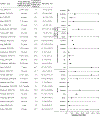Prevalence of Gestational Diabetes and Risk of Progression to Type 2 Diabetes: a Global Perspective
- PMID: 26742932
- PMCID: PMC6675405
- DOI: 10.1007/s11892-015-0699-x
Prevalence of Gestational Diabetes and Risk of Progression to Type 2 Diabetes: a Global Perspective
Abstract
Despite the increasing epidemic of diabetes mellitus affecting populations at different life stages, the global burden of gestational diabetes mellitus (GDM) is not well assessed. Systematically synthesized data on global prevalence estimates of GDM are lacking, particularly among developing countries. The hyperglycemic intrauterine environment as exemplified in pregnancies complicated by GDM might not only reflect but also fuel the epidemic of type 2 diabetes mellitus (T2DM). We comprehensively reviewed available data in the past decade in an attempt to estimate the contemporary global prevalence of GDM by country and region. We reviewed the risk of progression from GDM to T2DM as well. Synthesized data demonstrate wide variations in both prevalence estimates of GDM and the risk of progression from GDM to T2DM. Direct comparisons of GDM burden across countries or regions are challenging given the great heterogeneity in screening approaches, diagnostic criteria, and underlying population characteristics. In this regard, collaborative efforts to estimate global GDM prevalence would be a large but important leap forward. Such efforts may have substantial public health implications in terms of informing health policy makers and healthcare providers for disease burden and for developing more targeted and effective diabetes prevention and management strategies globally.
Keywords: Diagnosis; Gestational diabetes; Pregnancy; Prevalence; Screening; Type 2 diabetes.
Conflict of interest statement
Figures



References
-
-
Guariguata L, Linnenkamp U, Beagley J, Whiting DR, Cho NH. Global estimates of the prevalence of hyperglycaemia in pregnancy. Diabetes Res Clin Pract. 2014;103(2):176–85. doi:10.1016/j.diabres.2013.11.003.
This article estimates the global prevalence of hyperglycemia in pregnancy, including total diabetes in pregnancy (known and previously undiagnosed diabetes) and gestational diabetes, conforming to the new WHO 2013 criteria.
-
-
- Metzger BE, Lowe LP, Dyer AR, Trimble ER, Chaovarindr U, Coustan DR, et al. Hyperglycemia and adverse pregnancy outcomes. N Engl J Med. 2008;358(19):1991–2002. - PubMed
Publication types
MeSH terms
Grants and funding
LinkOut - more resources
Full Text Sources
Other Literature Sources
Medical
Miscellaneous

